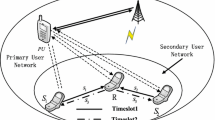Abstract
This work addresses the radio resource allocation problem for cooperative relay assisted OFDMA wireless network. The relays adopt the decode-and-forward protocol and can cooperatively assist the transmission from source to destination. Recent works on the subject have mainly considered symmetric source-to-relay and relay-to-destination resource allocations, which limits the achievable gains through relaying. In this paper we consider the problem of asymmetric radio resource allocation, where the objective is to maximize the system throughput of the source-to-destination link under various constraints. In particular, we consider optimization of the set of cooperative relays and link asymmetries together with subcarrier and power allocation. We derive theoretical expressions for the solutions and illustrate them through simulations. The results show clear additional performance gains through asymmetric cooperative scheme compared to the other recently proposed resource allocation schemes.







Similar content being viewed by others
References
IEEE-SA Standards Board. (1999). Wireless LAN medium access control and physical layer specifications: High-speed physical layer in the 5 GHz band, IEEE, New York.
3rd Generation Partnership Project Specifications Home Pages. http://www.3gpp.org/specs/specs.htm. Accessed April 2011.
IEEE-SA Standards Board. (2006). IEEE standard for local and metropolitan area networks part 16: Air interface. New York, NY.
Song, G., & Li, Y. (2005). Cross-layer optimization for OFDM wireless networks-part 1: Theoretical framework. IEEE Transaction on Wireless Communications, 4(2), 614–624.
Ng, T.C.-Y., & Yu, W. (2007). Joint optimization of relay strategies and resource allocation in cooperative cellular networks. IEEE Journal on Selective Area in Communications, 25(2), 328–339.
Kim, S.-K., Wang, X., & Madihian, M. (2008). Optimal resource allocation in multi-hop OFDMA wireless networks with cooperative relay. IEEE Transaction on Wireless Communications, 7(5), 1833–1838.
Jeong, H., & Lee, J. H. (2008). Adaptive relay selection for regenerative OFDMA relay networks with fairness constraints. Proceedings of IEEE vehicular technology conference, Calgary, Canada.
Tang, M., Wang, X., Wang, Y., & Liao, J. (2010). Dynamic resource allocation with threshold in OFDMA-based relay networks. Proceedings of IEEE vehicular technology conference.
Dang, W., Tao, M., Mu, H., & Huang, J. (2010). Subcarrier-pair based resource allocation for cooperative multi-relay OFDM systems. IEEE Transaction on Wireless Communications, 9(5), 1640–1649.
Zhou, N., Zhu, X., & Huang, Y. (2011). Optimal asymmetric resource allocation and analysis for OFDM-based multidestination relay systems in the downlink. IEEE Transaction on Vehicular Technology, 60(3), 1307–1312.
Tse, D., & Viswanath, P. (2005). Fundamentals of wireless communications. Cambridge: Cambridge University Press.
Chang, Z., & Ristaniemi, T. (2011). Radio resource allocation for cooperative relay-assisted OFDMA wireless networks. Proceedings of 3rd international workshop on cross-layer design(IWCLD), Rennes, France.
Yu, W., & Lui, R. (2006). Dual methods for nonconvex spectrum optimization in multicarrier system. IEEE Transaction on Communications, 54(7), 1310–1322.
Boyd, S., & Vandenberghe, L. (2004). Convex optimization, Cambridge: Cambridge University Press.
Ibrahim, A. S., Sadek, A. K., Su, W., & Liu, K. J. R. (2008). Cooperative communications with relay-selection: When to cooperate and whom to cooperate with. IEEE Transaction on Communications, 7(7), 2814–2827.
Jain, R. (2007). Channel models a tutorial1 v1.0. http://www.cse.wustl.edu/jain/cse574-08/ftp/channel_model_tutorial.pdf. Accessed April 2011.
Author information
Authors and Affiliations
Corresponding author
Appendices
Appendix 1
Derivation of optimal solution in (12) and (13).
For simplicity, we replace log(1 + P i s,k γ i s,k ) with r 1 and log(1 + ∑ K k=1 P j k,d γ j k,d ) with r 2. From (7), we have
Then the derivative of \(\mathcal{L}\) in (9) with respect to variable T 1 is given by
Since we have T = T 1 + T 2 and \(\frac{\partial\mathcal{L} }{\partial T_1}=0, \) the (22) can be converted to:
and we have
Appendix 2
Derivation of optimal solution in (14) and (15).
For simplicity, we replace P i s,k with P 1 and P j k,d with P 2,k . Similarly, we use G 1 and L 1 to replace G i s,k and L s,k , G 2,k and L 2,k to replace G j k,d and L k,d . First, we solve the power allocation at the transmitter. When relay selection and subcarrier allocation are done, the derivative of \(\mathcal{L}\) in (9) with respect to variable P 1 is given by
Substituting (24) into (26) and applying KKT conditions, we obtain
Then we discuss how to achieve optimal \(P_{2,k}^\ast\). The derivative of \(\mathcal{L}\) respect to P 2,k is shown
By using the same scheme that shows above, we obtain
Thus, the optimality of solution \(\hbox{P}^\ast\) in (14) and (15) is proved.
Rights and permissions
About this article
Cite this article
Chang, Z., Ristaniemi, T. Asymmetric radio resource allocation scheme for OFDMA wireless networks with collaborative relays. Wireless Netw 19, 619–627 (2013). https://doi.org/10.1007/s11276-012-0490-8
Published:
Issue Date:
DOI: https://doi.org/10.1007/s11276-012-0490-8




